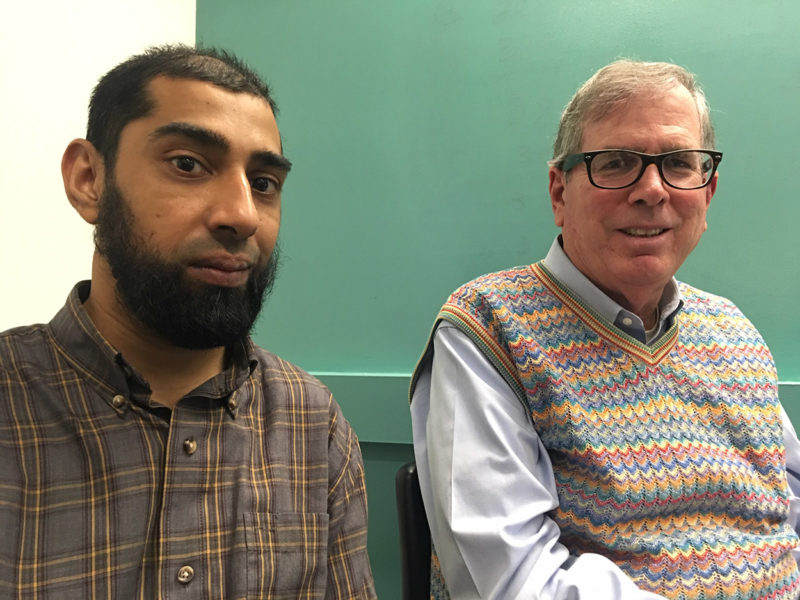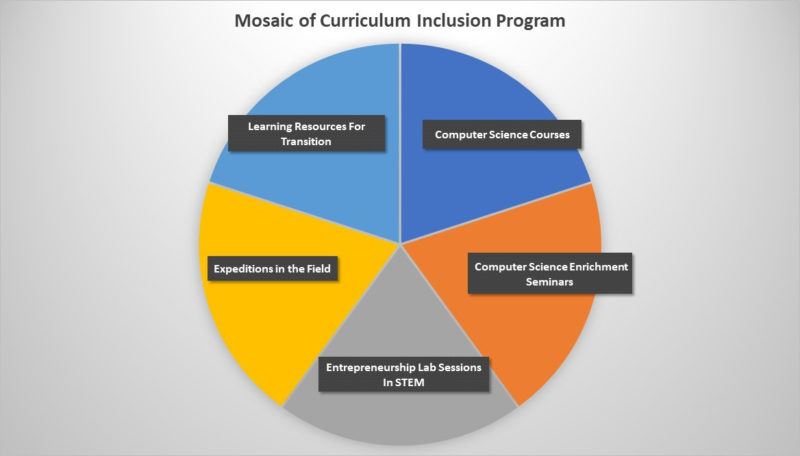Businesses are anxious for computer science professionals. However, colleges currently do not graduate enough students knowledgeable in cutting-edge STEM (i.e., science, technology, engineering and mathematics) skills (United States Equal Opportunity Commission, 2014). Computer science inclusion programs can better benefit businesses if more determined higher-functioning students with disabilities (Boccella, 2016) are included in the programs and if included can benefit such students in employment opportunities.

Adil Imran Sanai and James Lawler
Computer Science Inclusion Program
At Pace University in New York City, the Seidenberg School of Computer Science and Information System designed a computer science certificate non-degree program in computer science for motivated but nimble students with IDD having individualized education plans (IEP). The program is modeled on requirements from the Higher Education Act (HEA) of 2008: Programs for Students with Intellectual Disabilities in Higher Education (Grigal, Hart, & Weir, 2012) and the Think College! Standards and Benchmarks for Inclusive Higher Education Initiative (Grigal et.al., 2012). The students are included in the program with peer students without disabilities, in a fully inclusive setting in the school.
The program in the Seidenberg School is devised as an exciting experience in exploring and in learning computer science and information systems that can help the students in identifying opportunities in STEM, with a curricular and extra-curricular focus as follows:
Computer Science Courses
The program is focused on intermediate courses on leading edge technologies, such as the following:
- Creating Applications (Apps) on Internet;
- Data Base Management Principles;
- Java Programming I and II;
- Problem-Solving with Lego Robotics; and
- Programming in Python.
The students have already engaged in basic courses in community colleges or in high schools so that engagements in intermediate tools are a new opportunity, not a problem, for them. Most of the experiences in the courses involve projects with students without disabilities on self-directed teams, from which the students with IDD are learning not only from the instructors but also from the other students.
The courses in the program are held weekly.

Computer Science Enrichment Seminars
The program is also focused on learning the technologies from formal seminars, such as the following:
- Blockchain and Cryptocurrency Demystified;
- Building Internet of Things (IoT) Solutions; and
- CyberStorm: Depth of the CyberSecurity Threat.
From experts in businesses, the students are learning initiatives in the latest technologies not covered enough in the curriculum of the program. Their marketability is improving in learning the initiatives and in meeting in informal networking opportunities with the seminar speakers.
The seminars are held bi-weekly in the school.
Entrepreneurship Lab Sessions in STEM
The program is concurrently focused on the students learning to be members of teams relative to the technologies, such as from the following:
- Computing Nerd Fights;
- CyberSecurity Hackathons; and
- Mobile Applications (Apps) Contests.
The students with IDD are learning to be contributors, and especially for those with ASD, even innovators (Mone, 2017) on student teams in initiating ideas for the technologies as if they are in start-ups. From cooperative group-learning (Gregory & Chapman, 2013), they pitch solutions with the technologies to decision managers in businesses and start-ups that hire promising students. Their presentation skills are increasing with the sessions.
These sessions are held monthly in the school and in the university.
Expeditions in the Field
The program is involving the students in events or expeditions to businesses and start-ups, such as the following:
- Curriculum and Community Enterprise for Restoration Science (CCERS) Collaboratory in STEM;
- IBM ThinkLab Tour and Quantum and Watson Workshops; and
- Leadership in Technology Series: JPMorganChase Workshops.
The students are intimately learning more of the perspectives of scientists and technologists, and of the technological trends (Loten, 2018), than they are learning in the courses and the seminars, increasing their marketability in STEM.
These expeditions are generally held quarterly in the school.
Learning Resources for Transition
Finally, the program is involving the students with IDD in Career Technology Day Fairs and Technology Meet-ups, and with the resources of the university, so that their dreams to be in STEM might be realities, such as from the following:
- Computing Society Club Workshops;
- Crack the Job Interview Workshops;
- Enterprise Executive Speaker Series Workshops;
- Rock Your Resume Workshops; and
- Women in Technology Club Workshops.
The resources are offered by the internal Career Services department and by the Seidenberg School. This portion of the program is preparing the students for industry transition.
These resources are generally hosted bi-monthly in the school and in the university.
Impacts of the Program
The program is engaging 13 higher-functioning nimble students with IDD including ASD – 13 as a national norm for a post-secondary program for such students (Grigal & Hart, 2010) – in an aggregate of 12-15 courses in the fall and spring semesters (1-2 courses a semester) of 14 semester weeks in overall periods of 3 years.
The learning of intermediate skills in STEM (e.g., computer science and information systems) is a foundation for individualized plans for employment (IPE) that can be initiated by the students, plans from which most of them are migrating into industry jobs.
“Marketable skills for industry positions in technology are highly motivating for us,” says Adil Imran Sanai, an IDD participant student in the program who is planning to be a data base technologist with the City of New York. Moreover, the students are learning other skills, such as perseverance, presentation, problem-solving, thinking and time management, from group-learning (Gregory & Chapman, 2013) on mutual problem-solving teams. “The students have electronic portfolios of their skills in STEM, and these other skills, which are presentable to hiring managers in technology,” says Jim Lawler, organizer and professor of the program.
Essentially, most of these students in the program are being enabled for employment – an obligation for entrance into adulthood (Goldrick-Rab, 2016).
In summary, the benefits of computer science inclusion programs are clear for higher-functioning nimble students with IDD. These students are benefiting from a diversity of curricular and extra-curricular opportunities (Causton-Theoharis, Ashby, & DeClouette, 2009) as a post-secondary option that can benefit businesses and critically themselves – meaningful possibilities, moving beyond disabilities to abilities (Gay, 2013) – in key STEM technologies that lead to jobs. Computer science inclusion programs are definitely a fruitful proposition for transition into adulthood.
James Lawler, DPS, is Professor of Disability Studies and Information Technologies, Seidenberg School of Computer Science and Information Systems, Pace University, and organizer of the inclusion program in the school. Adil Imran Sanai is a participating student and one of the original pioneers in the program in the school.
For more information about the computer science inclusion program in the school, please contact Dr. Lawler at lawlerj@aol.com.
References
Boccella, K. (2016). College-bound students with autism learn to navigate campus life. Disability Scoop, November 11, 1-3.
Causton-Theoharis, Ashby, C., & DeClouette, N. (2009). Relentless optimism: Inclusive postsecondary opportunities for students with significant disabilities. Journal of Postsecondary Education and Disabilities, 22, 8-105.
Gay, G. (2013). Teaching to and through cultural diversity. Curriculum Inquiry, 43(1), 48-70.
Goldrick-Rab, S. (2016). Paying the Price: College Costs, Financial Aid, and the Betrayal of the American Dream. Chicago, Illinois: University of Chicago Press.
Gregory, G.H., & Chapman, C. (2013). Instructional Strategies. Thousand Oaks, California: Corwin, 131.
Grigal, M., & Hart, D. (2010). What’s the point? A reflection about the purpose and outcomes of college for students with intellectual disabilities. Think College Insight Brief, September, 1-4.
Grigal, M., Hart, D., & Weir, C. (2012). Framing the future: a standards-based conceptual framework for research and practice in inclusive higher education. Think College Insight Brief, 10, 1-4.
Loten, A. (2018). Talent gap widens as firms battle for artificial intelligence, data skills. Wall Street Journal, November 1, 1.
Mone, G. (2017). Bias in technology: As leading companies release troubling diversity statistics, experts search for solutions. Communications of the ACM, 60(1), 19-20.
United States Equal Opportunity Commission (2014). Diversity in high technology. Employer Information Equal Employment Opportunity (EEO-1) Report: United States Equal Employment Opportunity Commission, January 31, 3,5,35.





